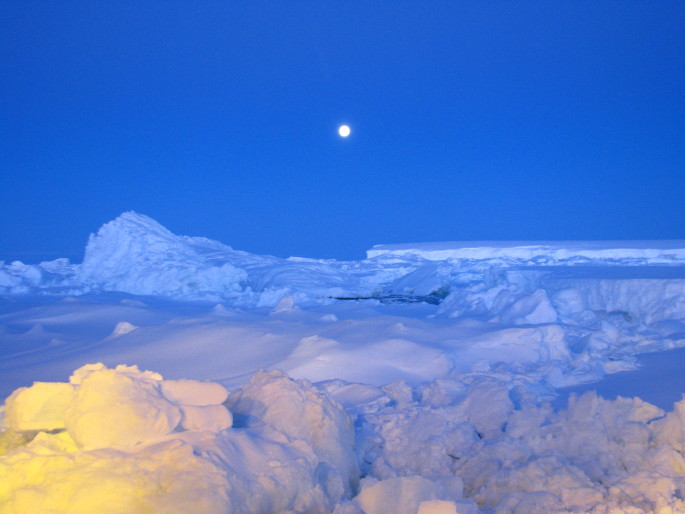March 6, 2014
Throughout the duration of this cruise, we have experienced all kinds of sea ice, from newly forming frazil and pancake ice, to large slabs of thick, multi-year fast ice and old pack ice. Thick sea ice can force course changes and delays, and cause frustration as our forward progress is slowed to rates of a few miles per hour or less. While the bridge crew works tirelessly to navigate through difficult ice, the science party must wait to resume data collection.
Over the past two days however, favorable winds opened up water in front of the Totten Glacier. We renewed our effort to reach Totten, pushing through navigable sea ice, and making it nearly as close as our first attempt to reach the glacier. Unfortunately, a change in the winds brought an increasing sea ice concentration and a tightening of the ice pack, forcing a change in course – back out to the open waters of the polynya to the east.
Sea ice presents a chess-like challenge to the mates in charge of sailing the ship, and they are playing against an unpredictable opponent. The ice makes it necessary to plan two steps ahead of the current position of the ship because sea ice distribution changes quickly with changes in wind speed and direction. Planning is aided by the knowledge that sea ice moves at a rate of 1/10th of a knot for every 10 knots of wind. For example, if the wind is blowing 20 knots, the ice travels in the same direction at 2/10 of a knot. Winds have the effect of putting pressure on the ice, making travel within the ice much more difficult. Pressure often pushes ice against the hull of the ship, closes our path behind us, and changes the placement of floes and bergs. The hull of the Nathaniel B. Palmer is reinforced with ice-hardened steel that is designed to break through up to 3 feet of sea ice while moving at 3 knots. However, as Chief Mate Brandon Bell states, “The true key to sailing through ice is patience.”
To sail through thick old sea ice, the mates employ a technique called backing and ramming. Unless an ice floe breaks apart or moves when the ship strikes it as we advance, the mates will set the ship in reverse and back off of the floe. The mates then navigate the ship forward again, hoping to strike the weakened portion of the floe. In this way, the forward progress of the ship is maintained but this process is time consuming and requires intense concentration. After two days of careful maneuvering within the ice, we broke back into the open water of the polynya this evening.
It is eerie when we find ourselves in the midst of a sea of ice and snow. Often, it is easy to forget that we are on the open sea. The flat expanse of white looks as though one could step off the back deck to make snow angels alongside the ship. It is a beautiful sight to behold but the power that the ice has over our course is never far from our minds.
Thanks to the perseverance and patience of the captain and the mates, we are back on track to continue working near the Moscow University Ice Shelf and Dalton Ice Tongue. It is a relief to see the blue of iceless water, and to be moving at 10 knots again after being waylaid by ice.
I can’t believe that we’re starting to wrap up the cruise! It’s going to be a very interesting experience not posting blogs anymore! As always, a big thank you for keeping up with us this whole time!


Mik,
It’s been fun to follow your adventure through this blog! Sounds like you’ve had a great trip!
Love and hugs,
Jen Mizener
Glad you guys are not stuck. Keep the safe journey going.